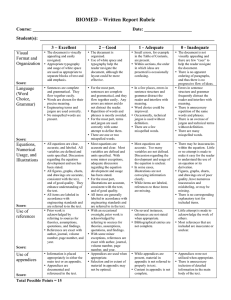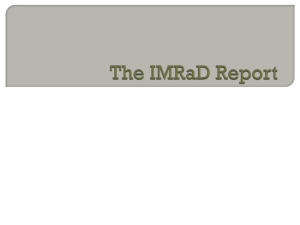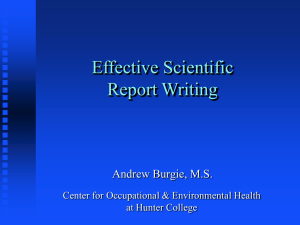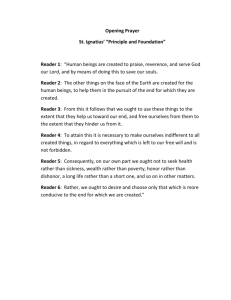Format and Style Guide for Laboratory Reports
advertisement
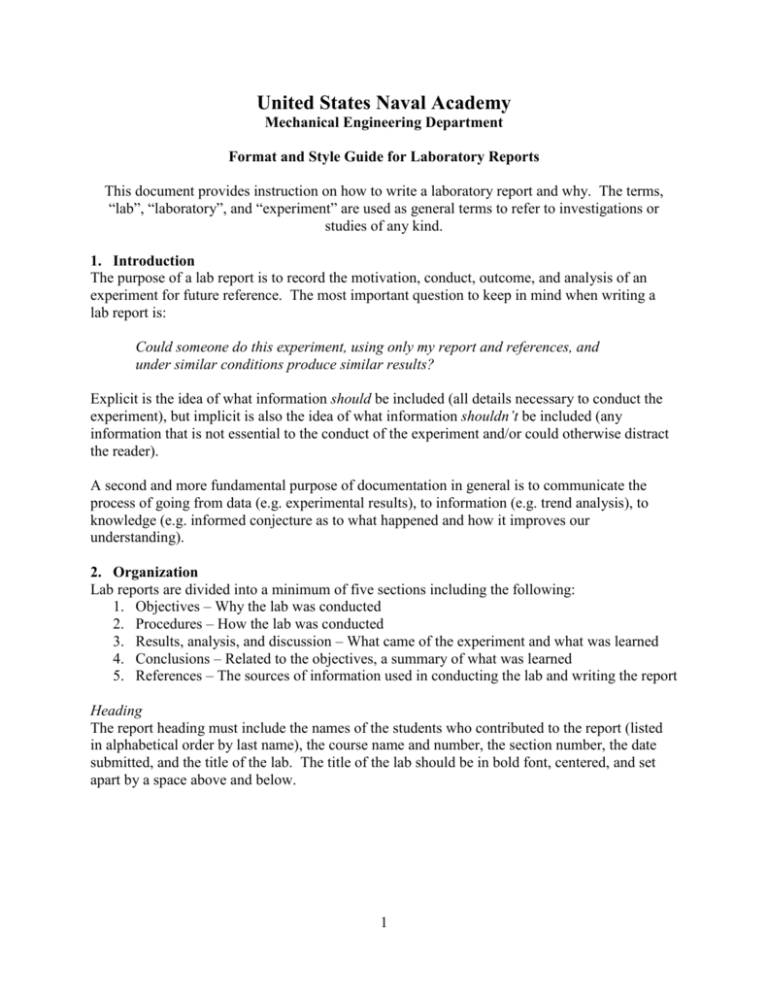
United States Naval Academy Mechanical Engineering Department Format and Style Guide for Laboratory Reports This document provides instruction on how to write a laboratory report and why. The terms, “lab”, “laboratory”, and “experiment” are used as general terms to refer to investigations or studies of any kind. 1. Introduction The purpose of a lab report is to record the motivation, conduct, outcome, and analysis of an experiment for future reference. The most important question to keep in mind when writing a lab report is: Could someone do this experiment, using only my report and references, and under similar conditions produce similar results? Explicit is the idea of what information should be included (all details necessary to conduct the experiment), but implicit is also the idea of what information shouldn’t be included (any information that is not essential to the conduct of the experiment and/or could otherwise distract the reader). A second and more fundamental purpose of documentation in general is to communicate the process of going from data (e.g. experimental results), to information (e.g. trend analysis), to knowledge (e.g. informed conjecture as to what happened and how it improves our understanding). 2. Organization Lab reports are divided into a minimum of five sections including the following: 1. Objectives – Why the lab was conducted 2. Procedures – How the lab was conducted 3. Results, analysis, and discussion – What came of the experiment and what was learned 4. Conclusions – Related to the objectives, a summary of what was learned 5. References – The sources of information used in conducting the lab and writing the report Heading The report heading must include the names of the students who contributed to the report (listed in alphabetical order by last name), the course name and number, the section number, the date submitted, and the title of the lab. The title of the lab should be in bold font, centered, and set apart by a space above and below. 1 Objectives The questions you want to answer in this section are: Why was this lab done? What where we trying to learn by doing it? The objectives section should be a short, concise statement. The lab objectives (e.g. to compare theoretical and empirical results) are not to be confused with the pedagogical objectives (e.g. to familiarize students with experimental methods, or to teach them how to analyze data using MATLAB, etc.). Although short, it is important that you consider carefully what, specifically, you want to learn from the experiment. Background (optional) The question you want to answer in this section is: What additional information would a reader need to know in order to understand and appreciate the following analysis? For labs that require some background investigation and/or additional explanation, that information should be presented in this section. Again, the goal is to summarize concisely the key findings of the research effort so as to provide the reader with the information and context necessary to understand the following sections. Figures and tables are preferable to lengthy descriptions. Procedures The questions you want to answer in this section are: What was done? How was the experiment conducted? Briefly summarize how the data was collected. It should be written in your own words, with a clear, professional voice. It may help to think of it this way: if a fellow engineer asked you, “What did you do in lab today?” the procedure section would be your brief but detailed explanation. Generally, the section should be no more than a paragraph, but should include all key details. It should reference but not reprint the procedures provided in an accompanying handout. Figures and/or schematics of the experimental set up can be very useful in communicating technical details. Results, analysis, and discussion The questions you want to answer in this section are: What was the result? Was it expected? Why or why not? How does this result inform our broader understanding? In this section, present the information – preferably in figures, plots, and associated descriptions – along with any other information pertinent to understanding your results (e.g. assumptions, test conditions, aberrations, etc.). In addition to describing what happened, you must also try to explain why, especially in cases when results are at odds with intuition, accepted values, or analytical predictions. 2 Note: Under no circumstances will “human error” be accepted as a source of deviation between expected and experimental results. As stated in the introduction, the analysis and discussion are really where the useful (knowledge) is created from the less-useful (data). Your discussion should include a logical, well-reasoned narrative and should clearly describe your thought process. After all, how you arrive at your conclusions is just as important as what they are. Conclusions The questions you want to answer in this section are: Did we answer the question(s) we set out to answer? If so, what did we learn? If not, why? The conclusions section is a summary of your findings and a brief explanation of their significance. It absolutely must reference the objectives of the experiment, describing how the objective was achieved. It should be quantitative (i.e. communicated with numbers) and overarching. A kind of executive summary, the reader should be able to get the gist of the experiment from reading this paragraph alone. The conclusion should not include general musings, vague comments about what the students learned from the lab (pedagogically speaking), or how the students feel about the experiment. Also, it should not contain any new information. References As stated in the introduction, the purpose of documenting the experiment is to provide others with enough information to recreate your experiment. As such, any reference material (e.g. lab handouts, text books, library materials, websites, etc.) used during the conduct of the experiment or the writing of the report (e.g. background information) must be documented so that it can be found by others. References shall be organized into a list in accordance with the Chicago Manual of Style author-date convention. A quick guide for in-text and end-note citations is available here: http://www.chicagomanualofstyle.org/tools_citationguide.html As a general rule, you’ll want to provide a reference for anything that isn’t common knowledge. For example, you need not cite a source when stating that in America, a right-handed traffic scheme is used. However, if asked to provide examples of incidents involving Liberty Ships, even if you’ve had a class that included a discussion of them, this would not be considered common knowledge and thus you’d be required to cite the source of your information. You may use endnotes, but not footnotes to cite your references. Make the report a separate section from the appendices (Page Layout Breaks Next Page), and set the location for endnotes at the end of the section, not the end of the document. See the sample laboratory report for more details. 3 Appendices Appendices are to contain any information that might be useful to the reader but would disrupt the narrative if included in the body of the report. For example, a computer code written to analyze data would be helpful to the reader (certainly if he or she is your instructor), and thus should be included in the report. However, inserting it in the body of the report would disrupt the narrative and distract the reader. The same can be said for tables of raw data, amplifying sketches, etc. Appendices must be referenced in the body text, and appear in the order in which they are referenced. They must also have a title and letter, appearing at the top of the first page of each separate appendix, and a description such that the reader can have skimmed the report and still have an appreciation for whatever is included. Unless instructed otherwise, include the lab handout (as a separate appendix) for reference. Note: Instructors may elect not to include the lab handout as an appendix. In this case you would cite it as a reference as necessary. 3. Style Lab reports shall be written in past tense as if you are documenting the experiment for the purposes of academic posterity - for the record, so to speak. The voice of the narrative shall be third person (e.g. “The car was released and rolled 4.5 feet”, not “We released the car…” or “He released the car…”). Although admittedly awkward there is a reason for this. As engineers it is our solemn charge to be objective; to fit our theories to the data not the other way around. Writing in the third person removes the experimenter from the experiment, preserving our sacred objectivity. As such, personal pronouns (e.g. I, we, our, etc.) are not permitted. Also, as engineers we appreciate specifics whenever available. Work hard to fill your narrative with numbers. Comparisons and descriptions should be quantitative. Don’t say, “The results were close” because close can mean different things to different people. Instead, quantify how close by providing the percent difference or percent error. Also, colloquial and/or flippant speech is distracting. Don’t use verbiage like “…a decent job,” “almost made it,” or “the third run sucked.” 4. Formatting Above all, the purpose of report formatting is to present the information contained therein in the most clear, concise presentation possible. The primary purpose of this guidance is to provide you with a simple format, but one that provides “good order and discipline” so as not to distract the reader. In general, all paragraphs are to be left-justified (as opposed to indented), and a space inserted between paragraphs. Figures, tables, and equations should be separated from body text by a space above and below for easy reading. 4 Numbers, counting, significant figures When it comes to including numbers and units in your description, the following guidelines might be useful: Measured or calculated quantities are always given in numerical format with units where appropriate (e.g. 4.2 m, 14.7 psia) o Use abbreviations for units (e.g. lbf as opposed to pounds-force) o There is no need to include a period after common units (e.g. lb instead of lb.) unless required to avoid confusion. When counting, if the absolute value of the number is nine or less, spell out the word o E.g. “During run number five…” When counting, if the value of the number is 10 or greater, use the number o E.g. “During run number 10…” Be sure to consider significant digits when reporting your findings and use scientific notation to avoid the appearance of presenting data with more precision than was available. As a general rule, you won’t be able to report values with more than four significant figures. Also, measured or calculated quantities less than one, be sure to include a zero in front of the decimal point so as not to have it mistaken for a period (e.g. 0.125 instead of .125 in). Figures, Tables, Equations, and Appendices The term figure is used to describe plots, images, diagrams – anything that isn’t a table. All figures will include numbers (e.g. Figure 1, Figure 2, etc.) captions describing the figure, and will be referenced somewhere in the body text (e.g. “Figure 1 shows…”). The caption for a figure goes below the figure. You always want to describe the figure for the reader, describing the axes and units, and state specifically what the figure tells you. Graphs (figures!) should include at a minimum: Axes set to a range which minimizes whitespace and emphasizes the data Axis labels of legible size, including units when applicable A legend if more than one data set is plotted on a single graph If multiple data sets are plotted on the same set of axes you should also consider using different markers (e.g. circles, triangles, squares, etc.) and different lines for trend data (e.g. solid, dashed, dotted, etc.) so that the reader can differentiate between data sets even if the report is printed in black and white. Symbols should be used to show discrete data, and lines for continuous functions like curve fits or equations. Tables must also have numbers, column headings with units, captions including descriptions, and must be referenced in the body text. The caption for a table goes above the table. In general, you do not want to include calculations in the body of a lab report. Instead, provide the governing equation. If calculations are needed to clearly explain the procedure or results, provide them in an appendix. Equations must be offset by a space both above and below, centered, and numbered. Equations are numbered sequentially, as they appear in the report and must be referenced just like figures and tables. Use of equation writing software is preferable to inline equations, e.g.: 5 𝑘−1 𝑘 𝑇2 𝑝2 =( ) 𝑇1 𝑝1 (1) as opposed to T2/T1=(p2/p1)^((k-1)/k) An explanation of Microsoft Equation Writer is available on the department website as is a list of shortcut keys and a very easy description of how to automatically format and number equations. The term appendix applies to any figure, table, or amplifying text that appears after the list of references. Appendices must be lettered (e.g. A, B, C, etc.), captioned including a description, and referred to in the body text. Each appendix should start on a new page although some information can be combined at the risk of wasting space (e.g. multiple tables of related experimental data can be arranged neatly on the same page). Appendices also appear in the order in which they are referenced. To be clear: If it’s a table and it appears before the list of references: it’s a table If it’s not a table and appears before the list of references: it’s a figure If it appears after the list of references: it’s an appendix 5. Summary The purpose of a lab report is to communicate to the reader the conduct of your report in the most clear and concise terms you can. If ever you are uncertain about whether or not something should be included or how something should be formatted, consider the quote attributed to Professor Einstein (perhaps erroneously, but the message still resonates): “Make things as simple as possible, but not simpler.” 6
